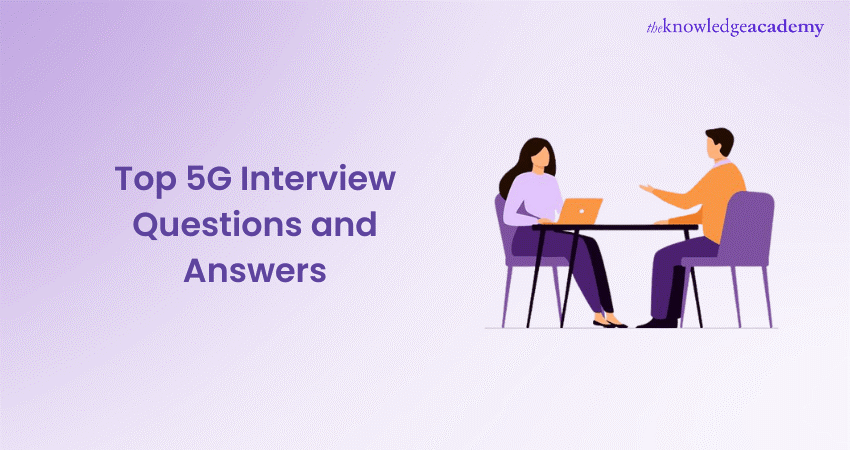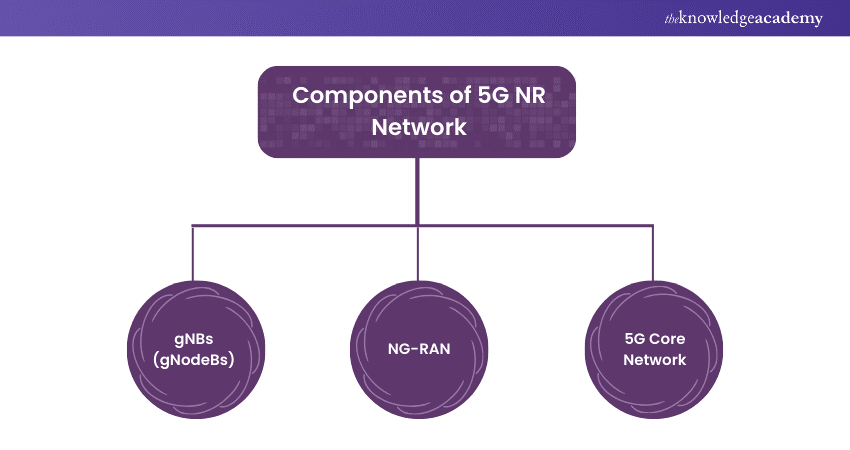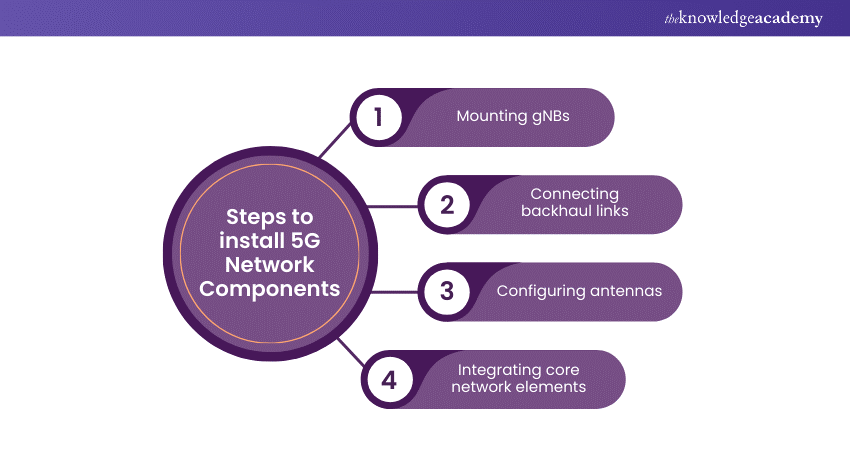We may not have the course you’re looking for. If you enquire or give us a call on + 1-866 272 8822 and speak to our training experts, we may still be able to help with your training requirements.
Training Outcomes Within Your Budget!
We ensure quality, budget-alignment, and timely delivery by our expert instructors.

With the rise of 5G Technology, interviewers for 5G jobs have become more frequent. Thus, aspiring candidates looking out for jobs in the IT industry must be prepared for 5G Interview Questions.
In this blog, we've put together common 5G Interview Questions and easy answers to get you ready. Read this blog to understand the basics for a successful next-gen talk in your interview. Let's delve in to learn more!
Table of Contents
1) 5G Interview Questions with Sample Answers
a) What does 5G NR (New Radio) entail?
b) Elaborate on the distinctions between TDD and FDD in the realm of 5G NR.
c) Enumerate and briefly explain the various handover types in 5G NR.
d) Define the applications of 5G NR, including eMBB, mMTC, and URLLC.
e) Outline the roles of MIB and SIB in the 5G framework.
f) Specify the range and speed characteristics of 5G NR Technology.
g) Identify the Key Performance Indicators (KPIs) employed in 5G NR.
h) Define the concept of CORESET in the context of 5G.
i) Explain the significance of Mini slot in 5G Technology.
j) Differentiate between 5G NR and 4G (LTE).
2) Conclusion
5G Interview Questions and Answers
From a seasoned professional to candidates just stepping into the world of 5G, the following questions will guide you through essential concepts. Let's see some 5G Technology Interview Questions and ensure you're well-prepared for the upcoming interview:
1) What does 5G NR (New Radio) entail?
5G NR, or New Radio, is the global standard for air interface communication in 5G networks. It brings a host of improvements over its predecessors, including higher data rates, lower latency, and increased reliability.
5G NR represents the latest advancement in wireless communication Technology, designed to deliver unprecedented speed and connectivity. It utilises advanced features like beamforming and massive MIMO to optimise data transfer, making it a pivotal element in the 5G ecosystem.
2) Elaborate on the distinctions between TDD and FDD in the realm of 5G NR.
Time Division Duplex (TDD) and Frequency Division Duplex (FDD) are two duplexing techniques used in 5G NR. TDD and FDD differ in how they allocate frequencies for communication. TDD is more flexible as it dynamically adjusts the ratio of uplink to downlink, optimising spectrum usage. On the other hand, FDD provides separate frequencies for uplink and downlink, ensuring simultaneous communication but with less flexibility.
3) Briefly explain the various handover types in 5G NR.
Handovers are crucial for seamless mobility in 5G networks. The three main handover types are intra-NR, inter-NR, and Xn-based handovers. Here's a detailed explanation:
a) Intra-NR handovers: Occur within the 5G network, maintaining the connection as the user moves within the coverage area.
b) Inter-NR handovers: Involve transitioning between 5G networks, ensuring uninterrupted service.
c) Xn-based handovers: Utilise the Xn interface for handovers between cells served by different gNBs, enhancing efficiency and reliability.
4) Define the applications of 5G NR, including eMBB, mMTC, and URLLC.
5G NR serves various applications categorised into enhanced Mobile Broadband (eMBB), massive Machine Type Communications (mMTC), and Ultra-Reliable Low Latency Communications (URLLC).
eMBB caters to high-data-rate applications like augmented reality, mMTC facilitates connectivity for a massive number of devices, and URLLC ensures low-latency and highly reliable communication, crucial for applications like autonomous vehicles and industrial automation.
5) Outline the roles of MIB and SIB in the 5G framework.
Master Information Block (MIB) and System Information Block (SIB) play pivotal roles in 5G networks. MIB broadcasts fundamental information like cell identity and bandwidth, facilitating device synchronisation. SIBs, on the other hand, convey more detailed and dynamic information, allowing devices to optimise their connection parameters and efficiently utilise the network resources.
6) Specify the range and speed characteristics of 5G NR Technology.
5G NR offers impressive range and speed characteristics, essential for diverse applications. 5G NR boasts an extended range, reaching up to 10 kilometres, coupled with remarkable speeds exceeding 10 Gbps. This ensures reliable connectivity in both urban and rural settings, while the high speeds support bandwidth-intensive applications, including high-definition video streaming and virtual reality.
7) Identify the Key Performance Indicators (KPIs) employed in 5G NR.
KPIs are crucial metrics for assessing the performance of 5G networks. In 5G NR, they encompass metrics like latency, reliability, throughput, and coverage. These indicators help operators gauge the Network's efficiency and make informed decisions to optimise and enhance the user experience.
8) Define the concept of CORESET in the context of 5G.
Control Resource Sets (CORESET) play a crucial role in the control signalling within 5G networks. CORESET is a set of resources dedicated to control signalling, ensuring efficient and reliable communication between the network and user devices. It allows for the prioritisation of critical control information, contributing to the overall efficiency of the 5G network.
9) Explain the significance of the Mini slot in 5G Technology.
Mini slots are a feature in 5G NR designed to enhance scheduling flexibility. They allow for more granular scheduling by dividing a slot into smaller units. This flexibility is vital for accommodating diverse communication needs, optimising resource utilisation, and supporting various services with distinct requirements in terms of latency and reliability.
10) Differentiate between 5G NR and 4G (LTE).
Comparing 5G NR with its predecessor, LTE (4G), provides insights into the advancements made in the new generation. 5G NR surpasses LTE in terms of speed, latency, and connectivity. With higher data rates, lower latency, and support for a huge number of connected devices, 5G NR redefines the possibilities of wireless communication, unlocking new opportunities across industries.
11) List the components comprising the architecture of a 5G NR network.
Understanding the architecture of a 5G NR network is essential for anyone involved in its deployment and maintenance. The 5G NR network architecture includes gNBs (gNodeBs), NG-RAN (Next-Generation Radio Access Network), and the 5G Core Network. The gNBs handle radio communication, the NG-RAN connects gNBs, and the 5G Core Network manages core functionalities like authentication, billing, and mobility."

12) Highlight the advantages of implementing 5G NR.
The adoption of 5G NR comes with advantages, shaping the future of communication Technology. Implementing 5G NR offers unparalleled speed, lower latency, and increased capacity, fostering innovation in diverse sectors. Enhanced Mobile Broadband, massive Machine-Type communication, and ultra-reliable low-latency communication open avenues for transformative applications, ranging from smart cities to autonomous vehicles.
13) Discuss the roles and uses of MIB and SIB within the 5G system.
MIB and SIB serve critical roles in the 5G system, ensuring efficient communication by providing fundamental and dynamic information, respectively. MIB aids in device synchronisation, while SIBs empower devices to optimise their connection parameters for seamless interaction with the Network.
14) Define uRLLC and its relevance in 5G NR.
Ultra-Reliable Low Latency Communications (uRLLC) is a critical aspect of 5G NR, catering to applications with stringent requirements. uRLLC ensures ultra-reliable and low-latency communication, making it indispensable for applications demanding instantaneous response times, such as industrial automation, remote surgery, and mission-critical services. Its high reliability sets the stage for revolutionary advancements in various industries.
15) Describe the deployment process of a 5G network.
5G network deployment involves meticulous planning, site preparation, equipment installation, and optimisation. The process encompasses radio access network deployment, core network integration, and thorough testing to ensure seamless connectivity and optimal performance.
Stay at the forefront of innovation with our Advanced Technologies Courses – sign up today!
16) Detail the installation steps for 5G network components.
Installing 5G network components requires precision and expertise. The installation process includes mounting gNBs, connecting backhaul links, configuring antennas, and integrating core network elements. Each step is crucial to ensure that the network components operate seamlessly, delivering the promised speed, reliability, and low latency.

17) Explain the measures taken to ensure network optimisation during 5G deployment.
Optimising the Network during deployment is essential for delivering a superior user experience. Network optimisation during 5G deployment involves fine-tuning parameters, optimising coverage, and adjusting interference levels. Continuous monitoring, performance analysis, and proactive troubleshooting contribute to maintaining optimal network conditions for end-users.
18) Define network slicing in the context of 5G.
Network slicing is a game-changing concept in 5G, allowing the creation of virtualised, isolated networks tailored to specific applications. Network slicing in 5G involves partitioning the Network into virtual slices, each customised to meet the unique requirements of different services or applications. This capability enables the efficient coexistence of diverse use cases on a single physical infrastructure.
19) Enumerate the key advantages of implementing network slicing in 5G.
Network slicing offers enhanced flexibility, resource optimisation, and tailored service delivery. It enables operators to efficiently allocate resources based on specific requirements, ensuring optimal performance for each slice and accommodating a diverse range of applications with distinct needs."
20) Can network slices be dynamically altered or generated?
Yes, network slices can be dynamically altered or generated to adapt to varying demands. This dynamic nature allows operators to allocate resources based on real-time needs, ensuring efficient use of network resources and the ability to support evolving applications and services.
21) How does network slicing guarantee isolation between different slices?
Ensuring isolation between network slices is crucial for preventing interference and maintaining service quality. Network slicing achieves isolation through dedicated resources and logical separation. Each slice operates independently, with its own set of resources, ensuring that changes or issues in one slice do not impact the performance or security of others.
22) Explore the differences between 5G RAN and its predecessors.
The transition from earlier generations to 5G RAN entails significant advancements. Notably, 5G delivers substantially higher data rates, offering faster downloads and reduced latency for an enhanced user experience.
The ultra-low latency of 5G is pivotal for applications requiring real-time responsiveness, such as autonomous vehicles. Additionally, 5G RAN accommodates a greater number of connected devices per unit area, addressing the escalating demand for the Internet of Things (IoT) and facilitating a more interconnected environment.
The introduction of network slicing is a distinctive feature, allowing the creation of virtual networks tailored to specific applications and ensuring efficient resource allocation. Moreover, the incorporation of advanced antenna technologies like massive MIMO enhances spectral efficiency.
23) Identify the primary components of the 5G Core Network (CN).
The 5G Core Network comprises the following key elements:
a) Access and Mobility Management Function (AMF)
b) Session Management Function (SMF)
c) User Plane Function (UPF)
d) Network Exposure Function (NEF)
Each component plays a distinct role in managing network functions and ensuring seamless connectivity.
24) Explain the functioning of V2V communication in 5G.
Vehicle-to-Everything (V2X) communication, including V2V (Vehicle-to-Vehicle), is a pivotal aspect of 5G. V2V communication in 5G enables vehicles to exchange information in real time, enhancing road safety and traffic efficiency. It facilitates coordination between vehicles, contributing to features like autonomous driving and collision avoidance, ushering in a new era of intelligent transportation.
25) Assess the impact of Network slicing on 5G OSS.
Operational Support Systems (OSS) play a vital role in managing and maintaining 5G networks. Network slicing impacts 5G OSS by introducing new complexities in resource management, service orchestration, and monitoring. OSS systems need to adapt to the dynamic nature of Network slicing to ensure efficient operations and deliver a seamless user experience.
26) How does 5G OSS facilitate network automation?
Network automation is a crucial feature of 5G OSS, streamlining operations and enhancing efficiency. 5G OSS facilitates network automation by leveraging Artificial Intelligence, Machine Learning, and advanced analytics. Automation in OSS expedites routine tasks, optimises resource allocation, and proactively addresses issues, ensuring a responsive and agile network infrastructure.
27) Define spectrum management concerning 5G.
Spectrum management in 5G involves the efficient allocation, assignment, and utilisation of radio frequencies. It ensures that each service or application receives the appropriate spectrum resources, minimising interference and maximising the overall performance of the Network."
28) Elaborate on the role of network planning in optimising 5G.
Effective network planning is fundamental to achieving optimal performance in 5G networks. It involves strategic placement of gNBs, careful consideration of radio frequency planning, and capacity planning to meet the specific requirements of diverse applications. Thorough planning is essential for ensuring seamless connectivity, high performance, and user satisfaction.
Unlock the future of wireless connectivity with our LTE Fundamentals Training – sign up today!
Conclusion
Being well-versed in these top 5G Interview Questions and answers will undoubtedly enhance your readiness for the next-gen talk in the telecommunications industry. Whether you're aspiring for a network deployment, optimisation, or maintenance role, a solid understanding of 5G Technology is critical to success. Good luck with your 5G interview!
Master 5G Wireless Technology with our 5G Wireless Training – sign up now!
Frequently Asked Questions

5G NR, or New Radio, represents the latest advancement, offering faster speeds and improved connectivity for a wide range of applications.

Network slicing allows the creation of virtualised, isolated networks, tailoring services for specific applications, ensuring efficient resource allocation and optimal performance.

The Knowledge Academy takes global learning to new heights, offering over 30,000 online courses across 490+ locations in 220 countries. This expansive reach ensures accessibility and convenience for learners worldwide.
Alongside our diverse Online Course Catalogue, encompassing 17 major categories, we go the extra mile by providing a plethora of free educational Online Resources like News updates, Blogs, videos, webinars, and Interview Questions. Tailoring learning experiences further, professionals can maximise value with customisable Course Bundles of TKA.

The Knowledge Academy’s Knowledge Pass, a prepaid voucher, adds another layer of flexibility, allowing course bookings over a 12-month period. Join us on a journey where education knows no bounds.

The Knowledge Academy offers various Advanced Technologies Courses, including 5G Wireless training, Conda Training, etc. These courses cater to different skill levels, providing comprehensive insights into 4G vs 5G.
Our Advanced Technology blogs covers a range of topics related to tech training, offering valuable resources, best practices, and industry insights. Whether you are a beginner or looking to advance your tech skills, The Knowledge Academy's diverse courses and informative blogs have you covered.
Upcoming Advanced Technology Resources Batches & Dates
Date
 LTE Fundamentals Training
LTE Fundamentals Training
Fri 24th Jan 2025
Fri 21st Mar 2025
Fri 2nd May 2025
Fri 27th Jun 2025
Fri 29th Aug 2025
Fri 3rd Oct 2025
Fri 5th Dec 2025







 Top Rated Course
Top Rated Course



 If you wish to make any changes to your course, please
If you wish to make any changes to your course, please


